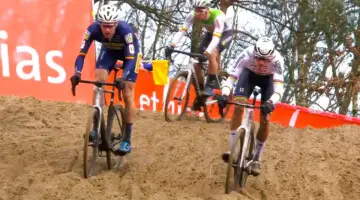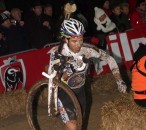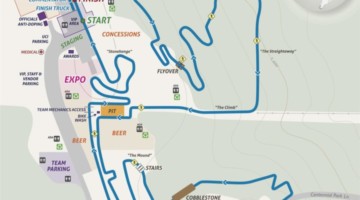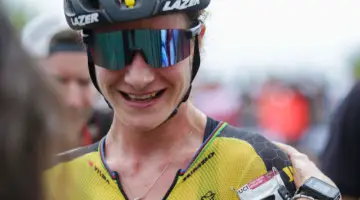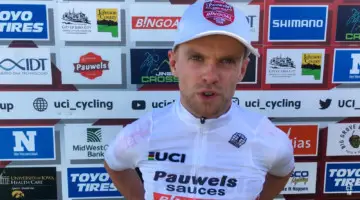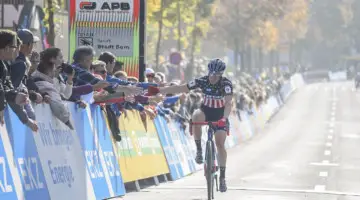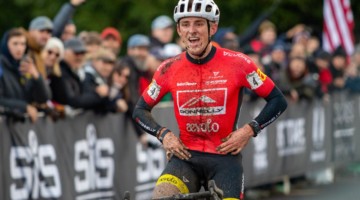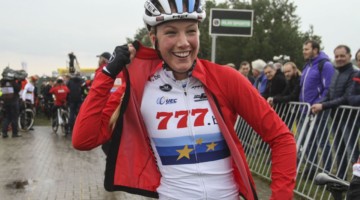If you guessed Niels Albert would be our profiled racer, congratulations! Dan Seaton, one of our regular contributors, interviewed Albert in February and asked him all of your burning questions.
by Dan Seaton
From the end of the 2008-09 season to the following fall, Niels Albert completely dominated cyclocross, claiming not just a World Championship at age 22 but also a string of 14 first and second place finishes by the fall. But by the end of last season, the fast start had worn him down, and Albert struggled with inconsistent results and could only watch as the championship jersey and a World Cup title slipped away from him at the hands of the rising Czech star Zdenek Stybar.
The 2010-11 season started similarly, as illness and injury knocked Albert out of the first month of the season. But by November, when he claimed his first win at the World Cup in Koksijde, the young Belgian was on the rise again, riding with new-found poise, reclaiming the World Cup title and finishing the year with 24 podium finishes.
Albert capped the season by riding away from Kevin Pauwels on the banks of the Schelde river in Antwerp to take his first Belgian Championship and don a jersey he long had dreamed about.
Back in February, Cyclocross Magazine sat down with Albert in his mobile home before the final race of the Superprestige series in Middelkerke to put your questions to the new king of Belgian ’cross.
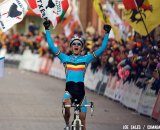
Niels Albert (Belgium) celebrates his victory at the 2009 UCI Cyclocross World Championships. © Joe Sales
Cyclocross Magazine: Do you think cyclocross should be a part of the Olympics? Even if it entirely had to be on snow?
Niels Albert: I don’t know. I think we have a big problem, because for the summer games cyclocross is [too much of] a winter sport, and for the games in winter there must be snow. So I think it’s always a little bit of a problem.
And when we talk about snow in the Olympic Games, it’s really big snow, and I think that’s not possible. I don’t see how you can ride on a [cross country ski] track with a bike.
But then we have a little bit of a weird season because it starts in September, and so the summer Olympics could be the first or second race. But there is mountain bike then, so I think it’s a little bit difficult too.
CXM: OK, let’s fast forward in time to Cyclocross World Championships in Koksijde in 2012. It’s the night before the race and you have some time to relax and decide to watch a movie. What movie will you watch?
NA: In my room before a big race, I think some action movie, maybe with Sylvester Stallone or — what’s the name of the guy with the long hair who talks a little bit easy — um, Steven Segal. Maybe that kind of movie is what I prefer.
But whether it’s the night before the World Championships, or [just a normal] week, it’s always the same category of movies. I don’t watch movies like Avatar, because it’s the future and it’s science fiction and those are nothing for me. I like movies with lots of cops, a little bit of fighting, or the mafia, always the same.
CXM: With Styby and Lars taking ProTour tram contracts, you’re the last of the new generation to stay completely focused on cyclocross. Will you stay with it or do you have ambitions to race Olympic mountain bike like Sven or go over to the road?
NA: For the moment cyclocross is very popular, so I think when you are choosing for [security] you stay in cyclocross. But nobody knows what happens when Sven and Bart stop riding, so maybe in three or four years, when maybe cyclocross will be a little bit down, when it’s not so popular, I could go maybe on the road or mountain bike. But now, cyclocross is very popular.
CXM: But don’t you think that when Sven and Bart all of their supporters will come over to you?
NA: Yeah, maybe, I hope so. And then I think cyclocross stays popular. So then when you choose for [security] or to make money in a safe way, [in cyclocross] I’m sure I’m with the three or four or five best guys in the world. When you go to the road or the mountain bike then you don’t know, and it’s always a little bit like, “What’s it gonna be? What’s it gonna be?” So I think for the moment I’d choose for security and then maybe later we’ll see.
CXM: What do you think about disc brakes in cyclocross? Will you use them?
NA: For the moment I think not, because they’re too heavy. But this week [ed. Middelkerke] we have something new from our team sponsor TRP. They have a V-brake. It’s for races like Koppenberg or Gavere, when it’s very, very downhill. And then you can ride with a V-brake on the wheel and it stops very well. And it’s not so heavy as a disc brake, so I think that’s maybe the future.
CXM: Have you tried them? How much better are they?
NA: I didn’t ride them yet, but I think we have one on the training bike. Maybe I’ll use it next week, but then the season is done, so I think it’s going to be used next year.
CXM: It seems we have seen fewer deep-section rims this year on the World circuit. Do you think this is this true? When do you like to ride these deeper rims?
NA: I don’t ride with big rims because those are more stiff; I use the low ones because it’s more comfortable in the field. In the sand, you use some [bigger rim], because it’s higher, and it’s going to make its own track, and cut the sand. In the mud, if you have lighter, low rims, the mud goes over the rim. So this is something you can think about; there are many, many theories about it.
I think we weighed [everything] in the beginning of the season, and the low rims are 100 grams less than the high ones. So I choose little ones more for the comfort, but I would choose the low ones anyway.
Now we heard from Shimano and I think they’re dropping the low rims next year, and they are coming out with a 35, and for next year I think I’ll have those. I have two or three for testing, and they’re really very good.
CXM: What are the best tires for conditions like last year’s world championships?
NA: I don’t know. [Snow] can be different. In Kalmthout I rode with a Rhino 30, but in Zolder it was fresh snow, and I rode with high wheels [and more open tread].
For the snow I have something special now. We have an old profile from the years of Liboton, and we have took it off and put it on a Dugast, and I think it’s the best tire you can have. It’s [like the Grifo, but] a little higher tread than the Grifo. Maybe you ride it one or two times a year, but not very often.
CXM: What about the tire pressure in those conditions? How do you decide about that?
NA: I think every race is different. Mostly I go out of the mobile home and my mechanic might say there is 1.5 or 1.6 [ed. about 22 or 23 psi] behind and usually that’s good. For me it changes from 1.2 to 1.8 depending on the conditions.
CXM: Do you ever put sealant inside your tires prior to a race?
NA: Once I did, when the World Championships where in Monopoli in 2003. I tried it then, but I don’t race with it anymore. It makes the tire [less supple], and now from Tufo there is a special tube that, when there is a [puncture], it helps close it. [So sealant isn’t an issue.]
CXM: One of our readers pointed out that you use Powercranks. Is this to improve your running or cycling and is this a once a week thing or an off-season training tool?
NA: I use Powercranks mostly in preparation for the new season, mostly in April. I ride most of the month with them, though not every day because it’s not possible. The max I can ride with them is two hours. When you train for four hours on Monday, then on Tuesday you can do two hours.
So I ride a little bit with them, but I think there are many, many ways to have a better feeling on the bike. Powercranks is just one.
At the professional level you get one percent here and two there and three from your food, and once you add all those small those things together you can maybe get back five or six percent. And at that top level, it makes a difference. Powercranks is one of those things, but I don’t think it’s enough by itself. I train with it, but Styby and Sven don’t.
I don’t think it helps with running so much. Powercranks helps me more with riding hills like at Koppenberg or Asper-Gavere.
CXM: Jeremy Powers asked us to ask you when you will come over and race with him in the United States.
NA: I think Louisville in 2013.
CXM: Not before then?
NA: I don’t think so, because the trip has to be in the beginning of the season, and then we have lots of races here in Belgium on the roads for preparation for the fields. And then when the road races are done, there are Erpe-Mere and some other [cyclocross races].
You know, for the fans, it’s very important that we race the first races of the year. They look forward all summer to those races, and when you’re then riding in the United States it’s really disappointing for them.
CXM: The European races seam to have much more running than races in many parts of North America. How much time do you spend training for the running parts of cyclocross?
NA: Most of the time it’s just once a week for half an hour. During preparation I do a little bit of running, a little bit of sprinting, a little bit up and down. We make some difficult exercises for a bit of power in the legs. But mostly, during the season, it’s just half an hour running, and always without the bike.
CXM: Another of our readers said, “I’m always impressed with how hard pro ’cross racers seem to work as they go into some of their biggest races.” What are the most important training tools for you when you taper in the last week before a big race?
NA: Rest is very important. It think it’s especially important the first two or three hours after a big training, but I’m a rider who doesn’t like the feeling of lots of rest two or three days before the championships.
Some guys want to rest [before big races] and some guys not. And I prefer to do a little bit of training, get a little bit busy. For my body it’s better to be steady, though for someone else’s body it could be different.
CXM: What’s your favorite cyclocross workout? What do you come back to week after week?
NA: The thing I [always try to do well] is rest.
But what I like the most about cyclocross [training] is actually in the last few weeks [of the season] when it’s like ten degrees [ed. About 50 degrees Fahrenheit] and the sun is shining and you can ride three or four hours on the road. That’s the thing I like most.
All winter you ride in the rain and snow and freezing and cold, and then at the end of the season it’s ten degrees and you can bike with no gloves and just a helmet, and no cap. That’s very nice.
CXM: Can you talk a little bit about your training over the course of the year?
NA: [After the season] I just rest one week when we have some [end of season celebrations] and then we have two weeks of vacation. And then we are coming back from vacation and we start training.
We start with basic fitness, mostly running, and then after one or two weeks you can start with the bike. In the first half of April we go for two weeks to Spain, and then in May we have the first races.
Summer is just preparation for the winter, but I think when the season starts in September you have to have 100 percent. When the season started this past September, I was not 100 percent. I had some troubles with my knee. And then to close the gap to the guys who are 100 percent was very hard. That’s why it took so long before I won my first race in Koksijde. Hopefully I get a good summer and get 100 percent instead of 95 for those first races.
CXM: But don’t you think, like this year, you started slow, but now you aren’t tired and a lot of other riders are struggling to keep going deep into the season?
NA: That’s the gap. I see Sven, who is older, is still good now for the moment. It’s true he didn’t ride great [in few of the first races], but he was winning races in the beginning of the season too.
CXM: What is your favorite place to train or to ride?
NA: For me, I mostly train at home [in Tremolo, northeast of Brussels]. And I ride a little bit to the south, like to Overijse [ed. site of the Vlaamse Druivencross], which is maybe 25 kilometers from my place. So when I start for a long training, maybe four hours, I start at my house and go to Leuven, Overijse, that kind of stuff.
In the woods I train in Langdorp, by Aarschot. Or sometimes I train in Ruien, which is by Kluisbergen, close to where the Koppenberg is. But most of the time I just train at my place, at home.
CXM: OK, we have one more question, about your sense of fashion. Why the switch to the all black socks?
NA: [Laughs] Well, because we used to be sponsored by Vermarc, and they made some white socks. But now we switched to Craft—we changed that on the first of January—and they have black.
For the moment it looks very good with my Belgian jersey [laughs again], but really I prefer white or another color. I think when the next season is started I’m going to ask Craft to make something special with the Belgian colors or something. We’ll see. When I was World Champion I had a white helmet with the stripes from the World Championship jersey, and so I asked Christoph [Roodhooft, BKCP team manager] if he would do something special for Belgium. So he’ll ask about it and we’ll see.










